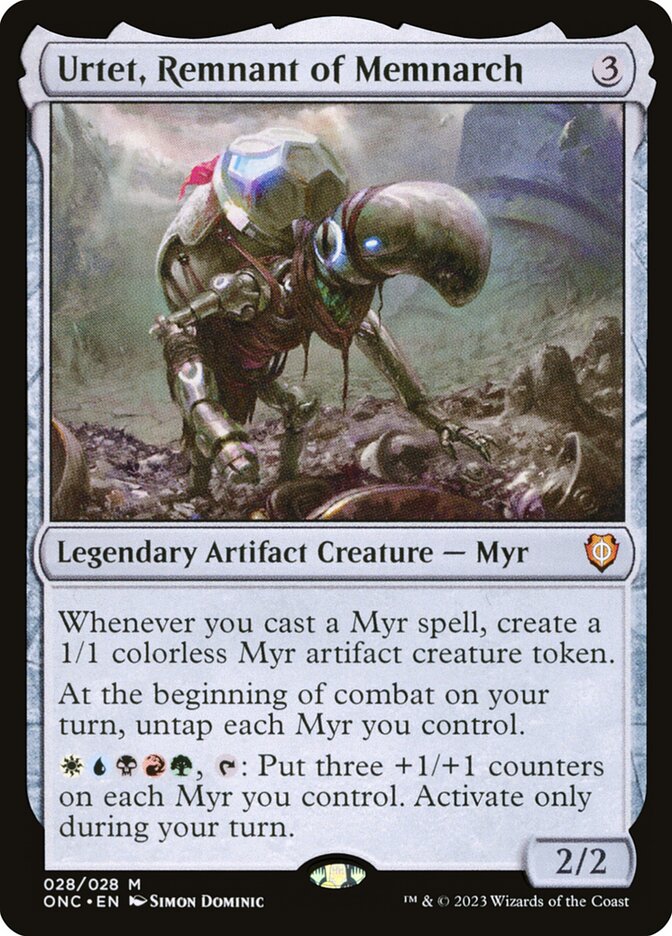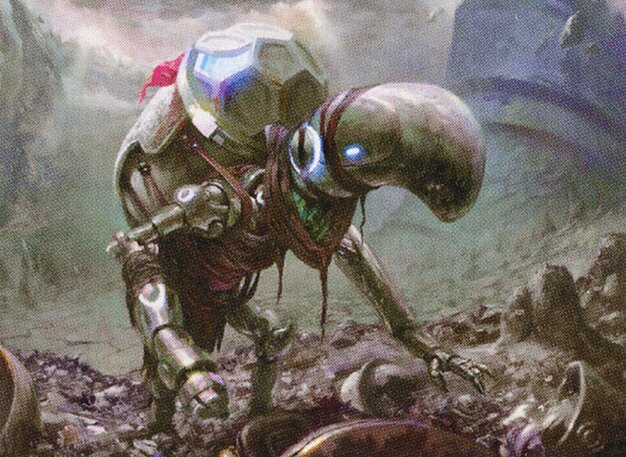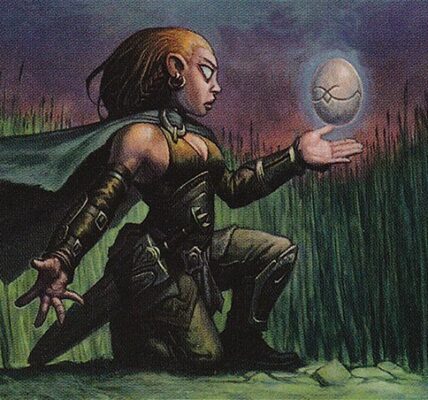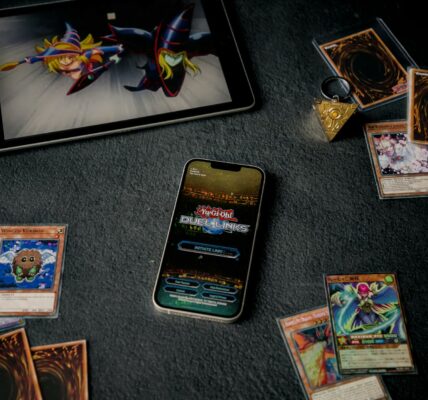Did Urtet, Remnant of Memnarch Make a Myr Tribal Commander Deck Competitive in Magic the Gathering?
Magic the Gathering is famous as being a very flexible trading card game in terms of deck building, with so many different strategies and creature tribes to build around. One of these creature tribes, however, has long been in need of a true leader. That tribe is the artifact Myr from the now-corrupted plane once known as Mirrodin, but now known as New Phyrexia.

In the Phyrexia: All Will Be One set, Urtet, Remnant of Memnarch has risen to become the five-color leader of the Myr tribe. While not found in the set proper, and is featured in a separate reconstructed Commander deck, Urtet can be found in All Be One Set Boosters and Collector Boosters.
While Urtet itself is a three-mana colorless artifact, thanks to the rules of the Commander format, Urtet has a five-color identity. This is because of its powerful tap ability which costs one of each color of mana to activate. Since you have nearly every card in Magic the Gathering history at your disposal in a five-color deck, there are many directions an Urtet deck may take. Of course, just like the name of the set in which it appeared, Urtet has just one best destiny, to lead a Myr Tribal deck to competitive relevance.
Who Was the Best Myr Tribal Commander Before Urtet?
It may strike you as odd, because it certainly surprises me, that the most famous Myr before Urtet was the very artificial being of which Urtet is a remnant of in Memnarch, wasn’t actually a Myr at all. No, Memnarch is a Wizard. But, from this lore mentioned on the MTG Wiki, you’d suspect Memnarch should have been classified as a Myr:
“Memnarch was the sentient incarnation of the Mirari who was driven mad by a mysterious oil. For most of the history of Mirrodin, he was the secret lord of the plane, plotting and manipulating the very structure of the world to realize his insane goals.”
Of course, we now know that the mysterious oil was Phyrexian, but this doesn’t explain why Memnarch isn’t classified as a Myr. After all, his two abilities don’t require him to be tapped, the only reason that he wouldn’t have been given the Myr creature type. Plus, while Memnarch was a powerful card back in its day, it has faded into obscurity.
Before Urtet, there has not ever been an official legendary Myr creature. Certainly, you could use Morophon, the Boundless as a Myr Tribal Commander, but that’s only because it’s a Changeling which can support any creature type in the entire game. The best Commander who actually could further a Myr Tribal strategy was Brudiclad, Telchor Engineer introduced in Commander 2018.
Brudiclad makes a lot of sense as a Myr Tribal Commander, as it supports creature tokens by giving them haste, and also creates a 2/1 blue and red Myr artifact creature token. Plus, Brudiclad then allows you to choose a token you control and make every other token you control a copy of that token permanently. It’s a neat Commander, for sure. But, there’s really no reason to force it into a Myr Tribal capacity, as its abilities are quite dynamic.
If Urtet, Remnant of Memnarch is So Niche, How is It So Popular in EDH?
While Urtet, Remnant of Memnarch seems pigeon-holed into the Myr Tribal niche, thanks to Urtet’s three abilities, that niche is actually extremely strong and competitive.
Two of Urtet’s abilities are static triggered abilities. The first is that whenever you cast a Myr spell, you create a 1/1 colorless Myr artifact creature token. That alone is extremely strong, giving you an extra body with each Myr you play. The second is more powerful, though; at the beginning of each combat on your turn, you untap each Myr you control.
Urtet’s final ability may cost each of the five colors of the Magic mana rainbow, but it’s well worth the investment. You put three +1/+1 counters on each Myr you control. While you can activate this ability during your turn, those counters are also put on Urtet itself (it doesn’t say each other Myr after all). Also, you can activate this ability during combat, and potentially twice in one turn, since Urtet will untap itself with its own ability.
Urtet also enjoys the benefit of a couple of infinite mana combos, which have existed in Commander for over a decade. These involve Myr Galvanizer and Palladium Myr along with either Clock of Omens or Sculpting Steel.
The Clock of Omens/Galvanizer/Palladium Myr combo is the better of the two, as you can gain infinite mana of any color Myr you control can produce. For this to work, you also need any other two Myr creatures, including tokens, in play. You tap Palladium Myr for two colorless mana, then activate your Myr Galvanizer for a single colorless mana to untap each other Myr you control. Then, you use Clock of Omens to tap two other Myr creatures you control to untap the Galvanizer and Palladium Myr. Rinse and repeat.
The Sculpting Steel/Galvanizer/Palladium combo can only generate colorless mana. Notably, Sculpting Steel is a great inclusion in a Myr tribal deck regardless, since it can come into play as a copy of any artifact you control for a mere three colorless mana. First, you copy Myr Galvanizer with Sculpting Steel. Then, you activate the Palladium Myr to get the two colorless mana, activate Myr Galvanizer, tap the Palladium Myr again, and finally activate the copy of Myr Galvanizer to untap all Myr again. Each time you repeat the process, doing so will give you one additional colorless mana.
Of course, you must then do something with all of this colorless mana. Fortunately, being in five colors, Urtet has access to a couple of very powerful win conditions. One of these is Door to Nothingness. While it typically comes into play tapped and costs a whopping ten mana to activate to make a target player lose the game, Urtet decks will make this much easier than normal. After all, you have artifacts like Clock of Omens to immediately untap the Door, and you have access to infinite mana with the Clock of Omens mana generation combo. So, you can actually wipe out an entire table in one turn if no one can interrupt the process.
One win condition that could come out of nowhere is an Enchantment called Mirrodin Besieged from Modern Horizons. When it enters play you choose either Mirran or Phyrexian. The Mirran mode is perfectly useful, as whenever you cast any artifact spell, you create a 1/1 colorless Myr artifact creature token. But, the Phyrexian mode is actually much more powerful. It reads:
“At the beginning of your end step, draw a card, then discard a card. Then if there are fifteen or more artifact cards in your graveyard, target opponent loses the game.”
Notably, just as with Door of Nothingness, this can’t take out the entire table in a multiplayer setting in one shot. But, thanks to Time Sieve being playable in the same deck – which requires you to tap it and sacrifice five artifacts to take an extra turn – it is very easy to take out at least two players using Mirrodin Besieged’s Phyrexian mode.
The other win conditions are very straightforward. One is to literally overwhelm opponents with more Myr than they can handle, pumping their power and toughness with tribal support artifacts like Coat of Arms and Obelisk of Urd. Eldrazi Monument can even give them +1/+1, flying, and indestructible for the mere cost of sacrificing a creature each turn. Of course, the +1/+1 counters from Urtet alone will probably win most games. Also, you have full reign to play Brudiclad in the deck, too, and we’ve already discussed his power.
Can Urtet, Remnant of Memnarch Lead Another Kind of EDH Deck?
While Urtet doesn’t have to rely on being a purely Myr Tribal Commander, its first two abilities require you to play predominantly Myr spells in your EDH deck. This means that while there will be many different variants of an Urtet Commander deck, they will all have Myr Tribal elements. Some will focus more on the token plan, others will focus on degenerate combos, and others will even run Jegantha, the Wellspring to tap for the five colors of mana to add some consistency to the deck’s win conditions.
Still, Myr Tribal with Urtet at the helm is a very competitive strategy in EDH. After all, Urtet being a cheap Legendary Creature to cast means it can keep coming back time and again even as the commander tax of two additional colorless mana each time it’s cast from the Command Zone stacks up. Because of how quickly you can spit out Myr spells and Myr tokens, Urtet leads a deck that can recover very quickly from board wipes. Even artifact hate isn’t going to slow this deck down for long.
With enough redundancy, a couple of infinite mana combos, and its win condition basically being able to overwhelm every opponent over the course of the game, Urtet decks should be feared in cEDH (competitive EDH), one-vs-one Commander, and traditional multiplayer Commander play groups alike.
There is one downside to Urtet, Remnant of Memnarch becoming such a popular Commander deck. Thanks to many of the best Myr cards being from older sets, a lot of the deck’s key cards will be increasingly hard to find as players scoop up every Myr and Myr-adjacent card they can get their hands on. So, it may be difficult for Commander players on a budget to build within the next year or so.
Fortunately, right now, the most expensive card commonly played in Urtet decks, according to EDHREC, is Myr Matrix, with a price tag just over $20 per copy. Myr Turbine is approaching $10. Potential win condition enchantment Mirrodin Besieged is also approaching $10. Granted there are many much more expensive cards commonly seen in these Urtet decks, such as fetch lands, token doublers such as Doubling Season and Anointed Procession, and Mycosynth Lattice, but none of these cards are essential to the functioning or win conditions of Urtet decks. They simply add additional power level and consistency commensurate with their high price tags.
Fortunately, most Myr are printed at common and uncommon, with many of their rare printings still easily found under $1 USD. So, it’s very possible to build an Urtet deck with a budget of $100 or less, although it will lack the power and consistency adding a few of the $5 to $10 cards could add. In particular, a $10-ish card like Cryptolith Rite will add consistency by ensuring that all creatures you control can tap for any color of mana. But, for at least the time being, you can rest assured that the bulk of your deck could be acquired from the bulk bins and dollar rare binders at your local game store.
If you’re looking for a new Commander deck to build, Urtet, Remnant of Memnarch is one that pretty much builds itself. Most of the more expensive cards in the deck are only holding higher price tags thanks to being useful in other EDH decks. So, if you get tired of playing Urtet, at least many of the more valuable cards could find their way into other decks. While building a five-color Commander deck can be daunting, Urtet itself doesn’t require that you include all five colors when you’re getting started. As an EDH deck that you can build up over time, Urtet is definitely a great candidate for budget minded and highly competitive Commander players alike.
Only two weeks after its release, Urtet, Remnant of Memnarch saw itself on the recent Top 10 Commanders list on EDHREC. While I’m not sure Urtet will continue to be a Top 10 Commander, as Legendary Creatures are printed at an alarming rate these days, it’s definitely the number one Myr Tribal Commander and one of the most accessible and easy-to-build EDH decks around.
What do you think of Urtet, Remnant of Memnarch?









RECENT COMMENTS